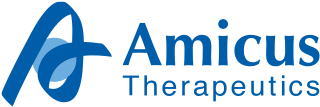
Gaucher's disease or Gaucher disease (GD) is a genetic disorder in which glucocerebroside accumulates in cells and certain organs. The disorder is characterized by bruising, fatigue, anemia, low blood platelet count and enlargement of the liver and spleen, and is caused by a hereditary deficiency of the enzyme glucocerebrosidase, which acts on glucocerebroside. When the enzyme is defective, glucocerebroside accumulates, particularly in white blood cells and especially in macrophages. Glucocerebroside can collect in the spleen, liver, kidneys, lungs, brain, and bone marrow.

Fabry disease, also known as Anderson–Fabry disease, is a rare genetic disease that can affect many parts of the body, including the kidneys, heart, and skin. Fabry disease is one of a group of conditions known as lysosomal storage diseases. The genetic mutation that causes Fabry disease interferes with the function of an enzyme that processes biomolecules known as sphingolipids, leading to these substances building up in the walls of blood vessels and other organs. It is inherited in an X-linked manner.
Niemann–Pick disease is a group of severe inherited metabolic disorders, in which sphingomyelin accumulates in lysosomes in cells.

β-Glucocerebrosidase is an enzyme with glucosylceramidase activity that is needed to cleave, by hydrolysis, the beta-glycosidic linkage of the chemical glucocerebroside, an intermediate in glycolipid metabolism that is abundant in cell membranes. It is localized in the lysosome, where it remains associated with the lysosomal membrane. β-Glucocerebrosidase is 497 amino acids in length and has a molecular weight of 59,700 Daltons.

Glucocerebroside is any of the cerebrosides in which the monosaccharide head group is glucose.

α-Galactosidase is a glycoside hydrolase enzyme that catalyses the following reaction:
Alglucerase was a biopharmaceutical drug for the treatment of Gaucher's disease. It was a modified form of human β-glucocerebrosidase enzyme, where the non-reducing ends of the oligosaccharide chains have been terminated with mannose residues.
Imiglucerase is a medication used in the treatment of Gaucher's disease.

Roscoe Owen Brady was an American biochemist.

Ambroxol is a drug that breaks up phlegm, used in the treatment of respiratory diseases associated with viscid or excessive mucus. Ambroxol is often administered as an active ingredient in cough syrup.

Miglustat, sold under the brand name Zavesca, is a medication used to treat type I Gaucher disease (GD1). It is also known as N-butyldeoxynojirimycin, and is a derivative of the anti-diabetic 1-deoxynojirimycin. It was developed by Oxford GlycoSciences and is marketed by Actelion.

Eribulin, sold under the brand name Halaven, is an anticancer medication used to treat breast cancer and liposarcoma.

The National Organization for Rare Disorders (NORD) is an American non-profit organization aiming to provide support for individuals with rare diseases by advocating and funding research, education, and networking among service providers. It was founded in 1983 by Abbey Meyers, along with individuals and rare diseases leaders of rare disease support groups, and it is a 501(c)3 tax exempt organization.
Velaglucerase alfa, sold under the brand name Vpriv, is a medication used for the treatment of Gaucher disease Type 1. It is a hydrolytic lysosomal glucocerebroside-specific enzyme, which is a recombinant form of glucocerebrosidase. It has an identical amino acid sequence to the naturally occurring enzyme. It is manufactured by Shire plc.
Taliglucerase alfa, sold under the brand name Elelyso among others, is a biopharmaceutical medication developed by Protalix and Pfizer. The drug, a recombinant glucocerebrosidase used to treat Gaucher's disease, is the first plant-made pharmaceutical to win approval by the U.S. Food and Drug Administration (FDA). Each vial has 200 units of taliglucerase alfa.

Protalix BioTherapeutics is an Israeli pharmaceutical company that manufactures a plant-based enzyme, taliglucerase alfa, which has received U.S. Food and Drug Administration approval for the treatment of Gaucher disease.

Eliglustat, sold under the brand name Cerdelga, is a medication used for the treatment of Gaucher's disease. It was discovered at the University of Michigan, developed by Genzyme Corp, and was approved by the FDA in August 2014. Commonly used as the tartrate salt, the compound is believed to work by inhibition of glucosylceramide synthase. According to an article in Journal of the American Medical Association the oral substrate reduction therapy resulted in "significant improvements in spleen volume, hemoglobin level, liver volume, and platelet count" in untreated adults with Gaucher disease Type 1.

Amicus Therapeutics is a public American biopharmaceutical company based in Philadelphia, PA. The company went public in 2007 under the NASDAQ trading symbol FOLD. This followed a 2006 planned offering and subsequent withdrawal, which would have established the trading symbol as AMTX Prior to their IPO, Amicus was funded by a variety of venture capital firms including Radius Ventures, Canaan Partners and New Enterprise Associates.

Migalastat, sold under the brand name Galafold, is a medication for the treatment of Fabry disease, a rare genetic disorder. It was developed by Amicus Therapeutics. The US Food and Drug Administration (FDA) granted it orphan drug status in 2004, and the European Commission followed in 2006. The European Medicines Agency's Committee for Medicinal Products for Human Use (CHMP) granted the drug a marketing approval under the name Galafold in May 2016.

Phenserine is a synthetic drug which has been investigated as a medication to treat Alzheimer's disease (AD), as the drug exhibits neuroprotective and neurotrophic effects.















